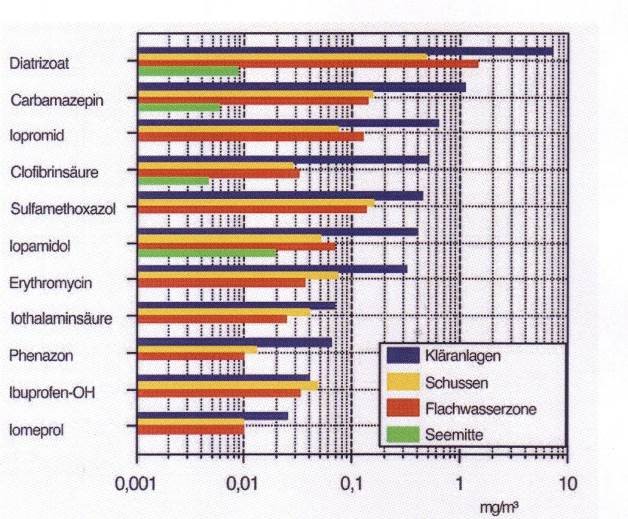EAA position on Hazardous Substances
 Hazardous substances - Pharma-Cocktails endanger our waterbodies
Hazardous substances - Pharma-Cocktails endanger our waterbodies
Existing national legislation prohibits any discharges of dangerous substances into waterbodies. That’s a clear directive. Not so clear is what counts as a dangerous substance. The EU and its Member States have listed a fistful of known chemicals under the Hazardous Substances Directive, but there are far, far more.
3.000 products are used alone in human medicine. These medicines are not only taken, they are also secreted. And so they are discharged in the sewage-water. Investigations have shown, all together about 100.000 chemical substances are produced and used around us. With some of them we know what damage they are causing, for the rest we can only imagine what they could do in the short term and in the long term we have not the slightest idea.
Products containing these chemicals are sold already in the medicinale, agriculturale and industrial sectors. In the past agriculturale pesticides were applied which contained the now banned substances of DDT and blue vitriol.
Blue vitriol was used in viticulture which caused mortalities when grapes were eaten unwashed, the use of DDT saw the rapid decline of aquatic life – the use of these is now banned. Nowadays we are facing similar issues with new chemicals which are powerful even in very small doses and are affecting the endocrine systems of living beings. A simple example will explain this. A caterpillar, harmful to crops, grows and pupates normally. But under influence of this insecticide it will never develop to a complete insect. And so this pest can’t propagate. It seems a very clever weapon against pests. But we don’t know the side-effects at the time. Or let’s have a look to the chemical industry. For instance, there are plasticizers, used to make PVC soft, and flame retardants to make synthetics flame resistant. And all these combinations also have effects on the hormonal system of animals and humans.

Here you can see the average contents of pharmaceuticals in the underruns of two purification plants (blue), the river “Schussen” (yellow), in the shallow water zone of the Lake Constance nearby Eriskirch (red) and in the open water of the Lake Constance (green)
It is obviously that the pollution is man-made and caused by purification plants.
References: Fischer & Teichwirt 12/2010
Effects on Humans and Fish
All these substances have effects on the endocrine system at Nanogramm-level. One Nanogramm means one Gramm of a product in one Million Litres of Water. And in such infinitesimal doses these substances work as endocrine disruptors.
“Research*eu”, the magazine of the european research area, has published in issue Nr.58 a four page article with the title “The elusive case of endocrine disruption”, relating to the harmful effects on the hormone system of animals and humans. It is estimated 80% of these products are discharged to waterbodies from sewage-water and at present most of our sewage treatment-systems cannot filtrate these hazardous substances.
For a long time nobody wanted to face these problems. Fishermen were the first to point this out. More and more aquatic animals have shown a decline of males, which means nothing other than continuous feminisation. In a lot of lakes Minnows have disappeared. With their short lifespan they were one of the first indicators of problems. Investigations on young men have shown everywhere a steady decline in male fertility. And also everywhere we are seeing an increasing number of cancers, especially breast cancers. More and more children are born ill. Meanwhile science has found out a lot more of the ill effects.
What does EAA want?
- European Parliament and the European Council to approve the proposal by the European Commission to increase the number of hazardous substances by a further 15 including oestrogens;
- Upgrading of sewage treatment works to include ozonation and activated charcoal tertiary units;
- Member States to conduct public awareness campaigns on the dangers of flushing medicins down toilets;
- Member States to encourage the public to change to using oestrogen products not dangerous to the environment.
Mixtures out of 100.000 products would result Millions of possible “Cocktails”.
For notes and references please download the position paper
Downloads: